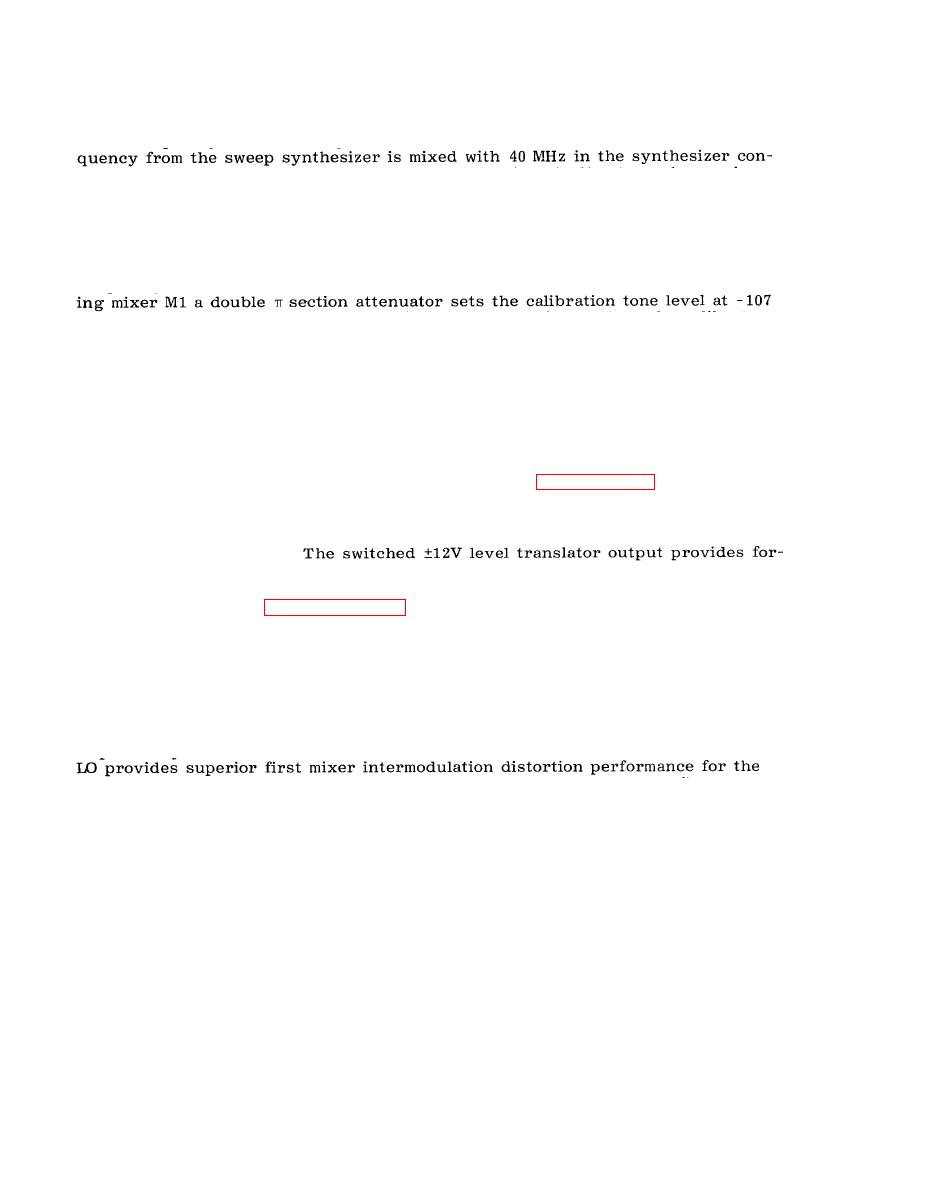 |
|||
|
|
|||
|
|
|||
| ||||||||||
|
|  TM 11-5820-917-13
provides an in-band sweeping signal of approximately -107 dBm at the receiver
tuned frequency over the range of 2 to 30 MHz. The 42.2 to 70.2 MHz LO fre-
verter to produce a 2.2 to 30.2 MHz output which is 200 kHz above the receiver
tuned frequency. This signal is fed to the receiver calibrator where it drives
mixer M1. A 1602.8 kHz crystal oscillator Y1-U1 is frequency divided by 8 to
produce a 200.350 kHz low level signal that is also fed to mixer M1. The output
of Ml is a double sideband suppressed carrier sweeping signal with 200.350 kHz
sidebands. The lower sideband is, therefore, 350 Hz below the receiver tuned
frequency and falls in-band; resulting in a 350 Hz baseband output tone. Follow-
dBm before it is applied to relay K 3 of the antenna switch. From the calibrator
relay K 3, the RF input is passed through two relay switchable attenuators K 4 and
K 5, 10 dB and 20 dB respectively, to provide 30 dB of front end attenuation in 10
dB steps, as selected by the 6025 unit. When the calibrator is enabled, the at-
tenuators are set to 0 dB.
4-77. Following the attenuator stage the signal passes through a 2 MHz high
pass filter to remove all signals below the frequency range of interest. The pre-
selector which follows provides bandpass filtering for the half-octave band of
interest. In practice, the eight half-octave filter stages (figure FO-32/2) oper-
ate in a sequential manner as the sweep progresses, starting with filter #1 and
ending with filter #8 (2-30 MHz). The filter select lines are driven from the pre-
selector decode circuit on the 6025 receiver control board and are level trans-
lated by Q1 through Q8.
ward biasing (+12V) on the selected filter while maintaining reverse biasing
(-12V) on the other filters. Only one filter at a time is enabled. Preselector
decide is described in paragraph 4-31.
4-78. Following preelection, the signal is amplified by a 10 dB linear class
A push-pull RF amplifier and enters the first mixer (M2). Mixer M2 combines
the 2-30 MHz RF signal with the 42.2-70.2 MHz output of the sweep synthesizer
to produce a first intermediate frequency of 40.2 MHz. The first mixer LO in-
jection from the synthesizer is amplified from 0 dBm to +13 dB m and is then con-
verted to a square wave drive by U4. The square wave LO signal is then further
amplified by U6 to +27 dBm to drive the first mixer. This 1/2 watt square wave
receiver. The 40.2 MHz IF mixer output is amplified in a 10 dB amplifier,
identical to the one used at the mixer input. After this initial IF amplification
(figure FO- 32/4), the signal is filtered by a 40.2 MHz crystal filter. This 10
kHz bandwidth filter provides selectivity to eliminate unwanted signals and noise
in the early stages of the receiver before the signal enters the high gain stages.
The filtered signal is then amplified by a third 10 dB RF amplifier before enter-
ing the second mixer (M3) (FO-32/5). The second mixer converts the 40.2 MHz
signal to the 200 kHz second IF. The 40 MHz local oscillator injection signal for
this stage is generated in the synthesizer. The 40 MHz output from the synthe-
sizer is amplified and passed through a series of gates to develop complementary
square wave LO inputs to the mixer.
4-79. RECEIVER OUTPUT SECTION. The receiver output section input is the low-
level 200 kHz IF from the receiver second mixer. The output section generates
two output signals: the baseband (0-500 Hz, or 0-5 kHz) signal (which goes to
|
|
Privacy Statement - Press Release - Copyright Information. - Contact Us |